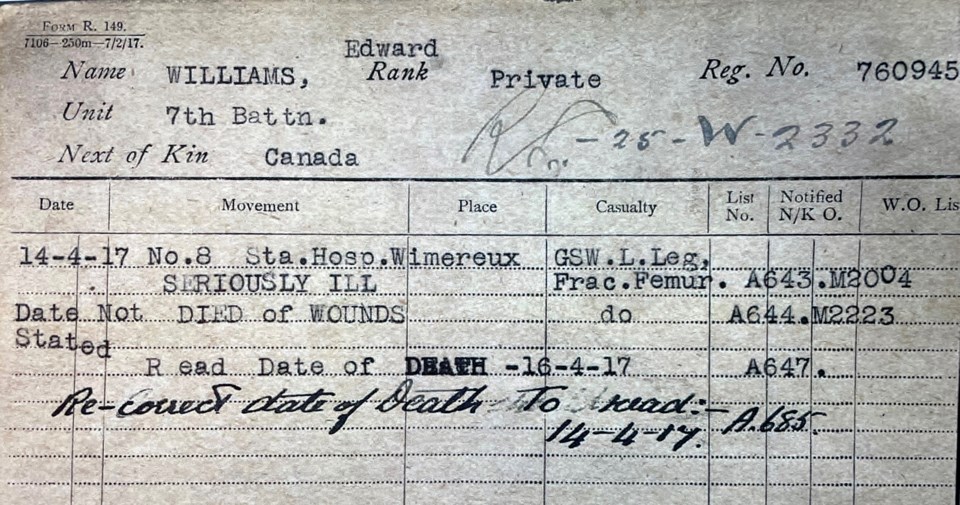Each name on Richmond’s cenotaph has a story but few of the soldiers whose names are engraved there still have living local family connections.
The name Edward Williams is etched in stone in front of Richmond City Hall, one name on a list of Richmondites who died in Canada’s wars.
Private Williams was possibly just 15 when he went to fight the “Great War,” the First World War. He fought at the Battle of Vimy Ridge on April 9, 1917, and died a few days later from his injuries.
Remembrance Day Committee chair Matthew McBride said he knows of only a few soldiers listed on the Richmond cenotaph with local family ties, so he was thrilled to be in contact with the great-nephew of Private Williams.
Doug Wilson, Pte. Williams’ great-nephew and Cody Brentzen, Doug Wilson’s nephew, are determined to make sure his name isn’t forgotten.
Brentzen will lay a wreath to commemorate Pte. Williams at Friday’s ceremony at the cenotaph and McBride will tell his story.
Finding family members of the soldiers makes Richmondites realize “this isn’t some ancient thing,” McBride said. And, he added, it begs the question “How would life have been different if this soldier had lived?”
Wilson knew Pte. Williams’ mother and remembers her speaking of him. Wilson is the last person who has direct knowledge of him.
But there are some mysteries surrounding the soldier, namely, what his real age was when he signed up for the Canadian Expeditionary Forces, who is “Ada Williams” listed as his next of kin, and whether there’s a marker for him in France where he died.
McBride said his next project is to ensure one is placed in France and possibly at Mountainview Cemetery in Vancouver.
Pte. Williams’ age is listed on his enlistment papers as 17 years and one month, or, as it’s noted, this is his “apparent age.”
But his mother Mary Corkill Williams, otherwise known as “Grandma Corkill” to Wilson, insisted he was only 15 when he joined up to fight the “Great War,” Wilson explained.
Pte. Williams listed his profession as “fisherman,” his address as the postal office in Steveston and his next of kin as “Ada Williams” his “widowed mother.”
It’s a mystery to the family who “Ada” was and why Pte. Williams would use that name for his mother.
While some mystery may surround Pte. Williams, the story of his life, how he served and fought at Vimy Ridge as a young Indigenous man is that “he was still growing up,” Wilson said.
Pte. Williams joined the 121st Battalion of the Canadian Expeditionary Force. He travelled to England on the Empress of Britain and arrived there on Aug. 24, 1916. Upon arrival in France on Nov. 29, 1916, he was transferred to the 7th Battalion.
Pte. Williams fought in the Battle of Vimy Ridge, which took place April 9, 1917, and was injured, with his medical records showing he fractured his femur and was taken on April 14 to No. 8 Stationary Hospital in Wimereux, a Canadian field hospital set up in 1915.
He passed away the same day.
But, for Wilson, as part of the Hwlitsum First Nation, originating in Steveston, keeping the memory alive of his great-uncle, especially his contribution as an Indigenous soldier, is paramount.
“Their memories flow through us, the living,” Wilson said.



